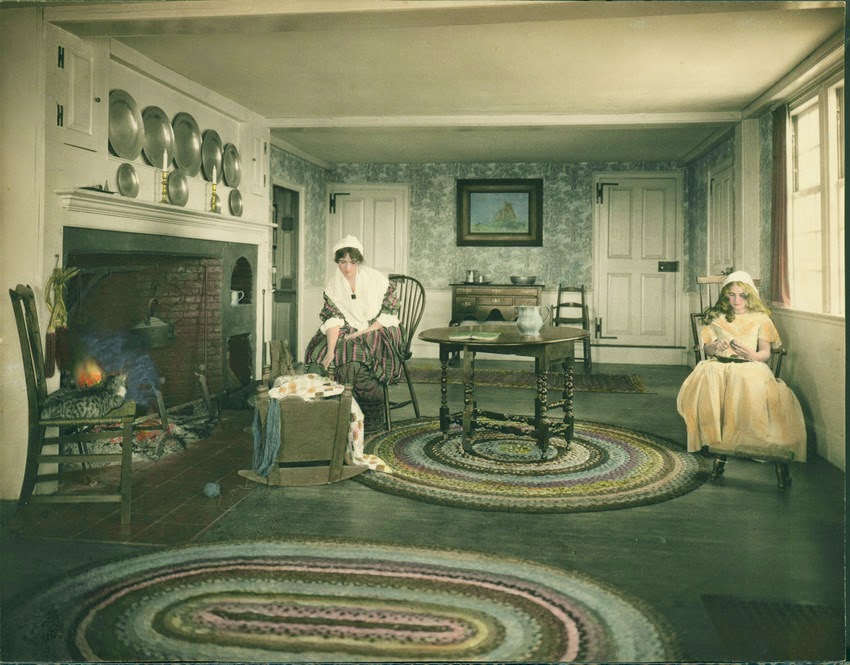 |
| “In the Brave Days of Old” |
 |
| “The Elaborate Dinner” |
Wallace Nutting was born in 1861 in Rockbottom, Massachusetts and enrolled at Harvard in 1883. During the summers he worked in hotels at various popular resorts in New England—Campobello Island, Martha’s Vineyard, Nantucket—that he would later return to as a photographer. After graduating from Harvard, he went on to Hartford Theological Seminary and Union Theological Seminary, becoming a Congregational minister in pulpits around New England.
In the early 1900s, however, Nutting began to suffer from neurasthenia--a disease peculiar to the Victorian era, characterized by fatigue, anxiety, and weakness, and thought to be caused by the stresses and strains of modern urban life. He left the church for good in 1904, and he and his wife, Mariet, purchased a derelict farm in Southbury, Connecticut. Nutting had been a dedicated amateur photographer since his college days, and photography was in fact often recommended as therapy for neurasthenia, because it combined artistic pursuit with healthful outdoor activity. He now turned to photography as a means of supplementing his income.
 |
| One of the many versions of “Cherry Blossoms” |
The subjects of Nutting’s photos were almost exclusively rural, and rarely showed any indications of modernity. Pastoral fields of cows, country lanes, blossoming trees, and old barns were some of his favorite subjects. These scenes of an unspecified but clearly pre-industrial era were enormously appealing to middle-class urban dwellers.
Between 1905 and 1912, Nutting (with Mariet’s assistance) perfected a system for producing high-quality colored photographs on a large scale. The photos were printed using the platinotype process and then tinted with watercolors, following a model, by a carefully-trained staff of young women. Nutting produced his first catalog in around 1910; it depicted over 500 photos and noted that many more were available. Prices ranged from $1.25 for the smallest pieces (5” x 7”) up to $20.00 for the largest (20” x 40”)—well within the reach of most middle-class consumers.
 |
| A typical Nutting colonial vignette |
While the outdoor views made up the bulk of the catalog, it was Nutting’s colonial interiors that were the most popular. By 1911 he was offering about 200 different interior scenes, which accounted for about a quarter of his total picture sales. Mariet Nutting had first suggested staging scenes with models—usually the young women who worked as colorists—to create “period vignettes.”
Though Nutting was producing his photos in the age of the “new woman,” the suffragette, and the flapper, his pictures showed women in decidedly traditional roles. Either they were shown engaged in genteel leisure activities—reading, writing letters, drinking tea—or in productive (but still genteel) work—spinning, sewing, cooking. In a time when gender roles were rapidly changing, Nutting’s pictures offered a reassuring vision of the past.
In order to make sure that the settings in his photographs were authentic, Nutting began to collect furniture, rugs, costumes, and other items that could be used as props. Then, to ensure that he always had suitable backgrounds, he began to purchase the historic properties which eventually would become the Wallace Nutting Chain of Colonial Picture Houses. The five houses, purchased and restored between 1914 and 1916, included the Joseph Webb House in Wethersfield, Connecticut; the Wentworth Gardner House in Portsmouth, New Hampshire; the Hazen Garrison House in Haverhill, Massachusetts; the Cutler-Bartlett House in Newburyport, Massachusetts; and the Ironmaster’s House in Saugus, Massachusetts.
 |
| 17th-century cupboard made by Wallace Nutting |
In addition to all his other ventures, Wallace Nutting was a prolific writer and lecturer. In the 1920s he began writing travel guides, the States Beautiful series, that took readers on virtual tours (illustrated with his own photographs, of course) of the states of the eastern seaboard. He also bolstered his reputation as a furniture expert with three books on the history of American furniture: American Windsors (1917), Furniture of the Pilgrim Century (1924), and Furniture Treasury (3 volumes; 1928 and 1933). Alice owned all of these books on furniture.
 |
| Photo by Wallace Nutting taken in the parlor of the Webb House. Note that the murals depict two of Nutting’s other properties, the Hazen Garrison House and the Saugus Iron Works. |
Above all else, Wallace Nutting saw himself as an educator, one with a very specific moral lesson to impart about the values of rural, pre-industrial America. That this idea owed as much to his imagination as it did to reality was unimportant. Nutting’s vision, combined with shrewd business tactics, tapped into a vein of nostalgia about the past and made him the foremost popularizer of the Colonial Revival in the early 20th century.
Sources:
Thomas Andrew Denenberg, Wallace Nutting and the Invention of Old America (New Haven: Yale University Press, 2003).
Richard Guy Wilson, Shaun Eyring, and Kenny Marotta, Re-Creating the American Past: Essays on the Colonial Revival (Charlottesville: University of Virginia Press, 2006).
Joyce P. Barendsen, “Wallace Nutting, an American Tastemaker: The Pictures and Beyond,” Winterthur Portfolio 18, no. 2/3 (July 1, 1983): 187–212.

No comments:
Post a Comment